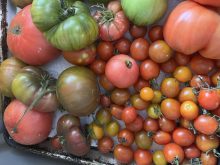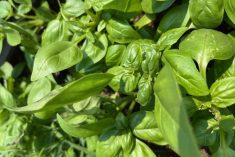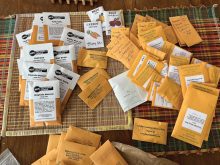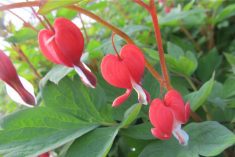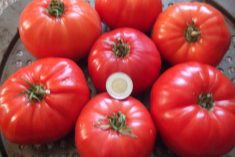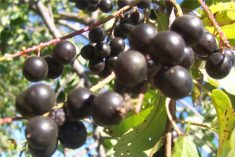For some time my thoughts have told me to write something about rosemary. An email with questions about wonderful herbaceous rosemary has spurred me on to say — today’s the day. I enjoy watching those TV commercials that say: “We’re egg farmers — we love what we do.” If that’s a signal I also love eating eggs; you’re right on the money. The antioxidants lutein and zeaxanthin in eggs help keep humans from getting eye diseases such as cataracts and age-related macular degeneration. Eggs have vitamin D, which is needed for grey matter. Eggs also have choline that helps nerve cells (neurons) in the brain talk to each other. Choline is also a very important nutrient for expectant mothers and breastfeeding women because of the big role it plays in brain development. Add to that — I recycle eggshells and make liquid calcium concentrate diluted in water to prevent blossom end rot on tomato plants. The method is provided further along.
Read Also

Gentle treatments for pain in the neck
Heading toward year-end, people unknowingly tense up against the cold and busyness, causing neck pain that can often be treated with appropriate support and gentle mobility, athletic therapist Kathlyn Hossack says.
Throughout last year my coiffeur told me a change is as good as a rest and recommends I wear different hats and caps. My headgear wardrobe holds many styles including my historic railway engineer cap that is designed with Singing Gardener icons sewn on with coloured threads. I have several western hats, plus an endless array of baseball caps. You know that old saying, what goes around comes around. Got to asking myself about an old fedora that I still wear from time to time — Will it ever become fashionable again? It has a feather on one side of the band. When I wear my authentic Tilley hat (see iconic hat symbol below) a lot of folks have said: “I see you’re wearing your fishing hat.” So I’m casting out not to catch a fish, but to extend a gesture of goodwill and welcome to all readers far and near — old-timers and new ones joining our Grainews family of readers. You’re all important. Oh, by the way, I’ve adopted a Tibetan proverb for 2019 with a message you can catch in my closing tag.
FROM THE EMAIL INBOX
Hello Mr. Ted:
First of all we wish you a Happy New Year and keep up the pages you have in Grainews!!!… always very interesting!! Would like to know if you are familiar with the rosemary plant. It is drying up on me!! Have followed the directions and yet it is drying up!! Let me know what you think!!!
– Denis & Louise Rosset, St. Claude, Man.
Ted’s input
First let it be known there are more than a dozen different rosemary species (Rosmarinus officinalis) and none is outdoor winter hardy in Canada. Two tougher rosemary varieties (description and availability provided further along) can do well in a few places on the southern lower mainland, the Gulf Islands and south coastal sections of Vancouver Island. Most rosemary perennials are rated for Zones 7, 8, 9, 10, 11-plus. That’s a far cry from our southern Prairie Zones 2 and 3. Rosemary does fine on balconies and decks in containers and planters when placed outdoors after danger of frost in bright filtered or direct sunlight between May through August. However, think of rosemary as a shivering giant — a description also applied to tomatoes. Canadian gardeners know most of us have no choice but to bring tender plants indoors for winter once days shorten and before frost. Introduce the change gradually so rosemary gets time to adjust with part of the day outside and indoors overnight. Besides natural light, provide at least six to eight hours of additional light each day by placing a lamp with a fluorescent plant growth bulb close by. Otherwise, it’s a challenge for any rosemary plant if left only in low indoor light to produce enough energy to stay alive. It’s actually part of the natural life cycle for needle-like rosemary leaves to mature and drop off while other leaves on the same plant remain green. Dried leaves can be collected and saved for cooking and medicinal purposes. Besides insufficient light there are these additional things that contribute to demise of a rosemary plant indoors. They include improper watering practices, powdery mildew and insect pests. Overwatering will cause root rot which can kill the plant. If soil is allowed to dry out completely, roots will die back and the plant will not have enough vitality to rebound. Water only when surface soil is dry to the touch and be certain the bottom drainage hole on the container is not obstructed so excess water can drain away. Pests are rarely to blame for killing rosemary. If you see bothersome fungus gnats fluttering about your face, buy a pack of sticky-sticks houseplant traps at any garden centre, or make your own by thinly pasting petroleum jelly on four-inch cut-out squares from a sheet of stiff yellow paper available at dollar stores. Or, place a dish of 50/50 per cent apple cider vinegar and water nearby any plant where gnats are visible. They’ll either get stuck or drown. Powdery mildew is the main affliction that can develop on rosemary plants. One of the best things to keep it away is good air circulation. Place a small indoor household fan near the rosemary to blow air around the room for an hour or longer daily. Do the same thing to circulate air around tomato seedlings after their first true leaves are formed to avoid damping-off disease.

If all this seems too bothersome, try the following. I let my rosemary go semi-dormant in natural light, away from drafts and give it only enough water to keep it alive and let it do its own thing. Yes, there are green needles but most have dried so I collect those. On February 15 coming up, or thereabouts two changes are introduced. I shall shape and prune back the stems by one-third and place the rosemary in the brightest natural light possible. Some supplementary grow light may also be given. I’ll also begin a feeding program with some liquid plant food for foliage and evergreen plants mixed at half strength (i.e. 50 per cent) of label directions. Some nurseries and greenhouses provide overwintering space for dormant or semi-dormant rosemary plants in a controlled environment for a fee.
Want to buy a rosemary plant?
Here are a couple of varieties to consider. Hill Hardy Rosemary (Rosmarinus officinalis “Madeline Hill”) is known to have survived most winters in Zone 6, developing into a nice low shrub. This is an elite variety with finely scented greyish leaves displayed in a neat compact habit. Arp Rosemary (Rosmarinus officinalis “Arp”) is known to also have survived some outdoor winters in Zone 6 with protection. Foliage is grey green with nice aroma. The leaves are used to add flavour to home cooking and pickling. Both named rosemarys are available as started plants from Richters Herbs in Goodwood, Ontario L0C 1A0; phone toll free 1-800-668-4372.
Make liquid calcium from dried eggshells
Blossom end rot affects tomatoes and other edibles including peppers, eggplant, squash, zucchini and even watermelon. Eggshells are 90 per cent calcium, plus have some magnesium, sulphur, iron, manganese, phosphorus, zinc, fluorine, copper, molybdenum and chromium. The three ingredients to make a batch of liquid calcium are finely crushed or powdered eggshells, vinegar and water. To each tablespoonful of eggshell powder, add one tablespoonful of white vinegar (or a tad more if desired) and stir together. Let it fizz for a half-hour or longer to free up and release calcium then drain off the concentrate into a small container through a cheesecloth or coffee filter. Pour it into an empty four-litre jug, fill with water and mix well. Pour one litre of prepared calcium tonic into the bottom of each planting hole and let it soak in for half an hour. Any leftover traces of calcium bits in the coffee filter can be stirred into a hole bottom. Later in the season, fill a mister or watering can with prepared calcium tonic. Mist or spray the tonic in early morning all over tomato plant foliage letting any excess drip to the ground. Begin first misting as soon as tomato blossoms start to appear and repeat weekly on opened flowers and forming fruits.
Do you have luck or no luck at all?
I’ve entered a few draws over the years myself. We all know you can’t win if you don’t try and there’s no guarantee. Twelve persons will each receive a packet of tomato seeds in the mail following draws in March. Sure it’ll cost a buck to mail an entry and the prize doesn’t sound like much, but in the process we might just activate more letter writing as in days of yore. Remember pen pals? If you’re up to entering, let’s hear from you. Send your entry to:
Ted the Singing Gardener
Tomato Seed Draws
Grainews
1666 Dublin Ave.
Winnipeg, Man. R3H 0H1 GN




